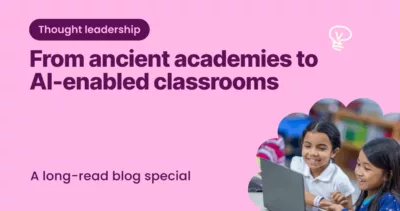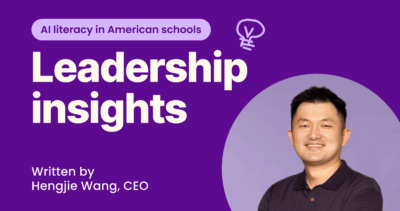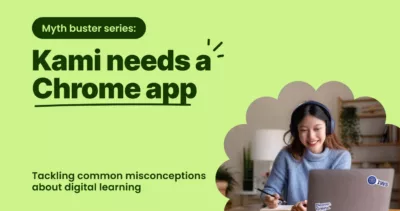Kami Connect Speaker Sessions | Steve Martinez
I know that Project-based Learning (PBL) might not be new to all, but for some, it’s a relatively new concept that can seem pretty foreign. Thankfully, it doesn’t have to be – that’s why my two main goals for this piece include explaining how I got started with PBL and how it’s currently going! It’s that getting started part that can really be your first big hurdle if you’re new to Project-based Learning. Let’s demystify things a little bit by getting into what PBL actually is.
What is Project-based Learning?
There’s no one right way to define Project-based Learning, though you’ll find similarities depending on who you’re talking to. Simply put, PBL allows students to explore various skills such as inquiry and complex problem-solving – it allows students to be a part of something bigger than themselves. To get my own footing with PBL, and find out what not only works for me but my students too, I ventured off into my own inquiry. Specifically, reading this book.
Why Project-based Learning?
There’s no better answer to the why than moving the classroom priority to teach with students’ passions and hearts in mind. Curriculum, standardized testing, and benchmarks are part of our world in education, but Project-based Learning allows teachers to have students learn with their hearts and concerns at the forefront of their neighborhoods and communities.
What’s Involved?
PBL normally has the ingredients of a driving question or what I like to call, “wicked problem”. Allow students to explore that question or problem by tapping into their own passions. This empowers students to let their curiosity and sense of inquiry lead their collaborations, critical thinking, creativity, innovation, and real-world problem-solving.
For me, it’s important to present problems and questions to students that are authentic. Students don’t want to solve the questions that are in the back of a textbook, but rather the problems that they’re passionate about. It’s amazing to hear from students when they’re empowered to speak on their passions and the problems they are passionate about.
While teaching with PBL, I’m often reminded to teach passionately, and learn humbly. The PBL experience gives students and their teacher the perspective of what’s most important: We are all human, attempting to navigate our lives through the plethora of problems we face. Why not make school about being human and how to arm our children with the hurdles that come with life.
Getting Started with Project-based Learning
It’s best to start with getting students to analyze or break down an “Umbrella Question” (different term but same meaning as a Driving Question). This can be done by allowing students to ask their own supporting questions to better understand the question(s) they have to begin to answer or solve the Umbrella Question.
The next logistical step would be to have students work through a Progress Assessment Tool. This allows students to explore content standards, literacy standards, or goals for a class to build learning targets that will get integrated into a project by the students. Instead of a teacher telling the students what to master, the students get to tell the teacher what they are going to master. This doesn’t mean that certain standards get ignored; a teacher can still direct the learning in a way that addresses all standards, the only difference is that the project becomes the focal point of the classroom experience. This way, students feel empowered because they have a high level of choice and voice with how they’re using the project as a vehicle for learning. The Progress Assessment Tool is a place for students to write their learning targets and document how they are seeing success (aka meeting the learning targets or exploring skills that are desired by the students). It’s also a place for real-time feedback as students are trying to integrate the learning targets and the data collected from the supporting questions into a project of their choice.
Students themselves bring in all the elements for the ultimate goal of answering the Umbrella Question – by giving them this freedom, students take more risks and explore different prototypes of products based on the skills that they want to work on. Some students may create a documentary, while another student may do something that is not too tech-heavy like writing a song.
Grading throughout projects
As weird as it sounds, I don’t like to grade the projects. I do observe and appreciate the hard work students put in, but instead, the main assessment is the students doing a final reflection on their project. I’ll grade based on how they answer the learning targets that they wrote earlier in the process. This isn’t a stressful unit exam at the end of a semester or unit, but rather gives students the opportunity to show off what they learned through the PBL experience relative to the learning targets that they developed.
I also give students the ability to approach me with feedback on the entire experience. This includes the nature of the project, the intended audience that may be involved, the quality of mentors that are frequently involved, and my overall teaching. This can be scary to open this door to students, but I’ve found that this breaks down walls between me and my students. Building trust in this way is good for students, and it’s good for teachers.
Taking PBL to a Different Level
With time, I’ve managed to amp up my PBL practice with my high school seniors. This involves using Design Thinking (Empathize, Define, Ideate, Prototype, and Test) and Cross-Curricular instruction. I created a one-of-a-kind template with the goal of giving educators a starting point of how to create a cross-curricular experience that allows students to solve a problem using Design Thinking.
If you’d like to know more, I’ve also done a Teacher Teacher podcast session and blog that explores PBL even deeper. Check them out!
Want to chat?
I’m always looking for global collaboration to develop cross-curricular instruction for students – particularly with mentors. I’m also up for a more hands-on training collaboration with others out there interested in this type of work. You can find me on Twitter: @Martinez_EdTech or on my website!
Resources
You may also like

From ancient academies to AI-enabled classrooms

Improving AI literacy in American schools


